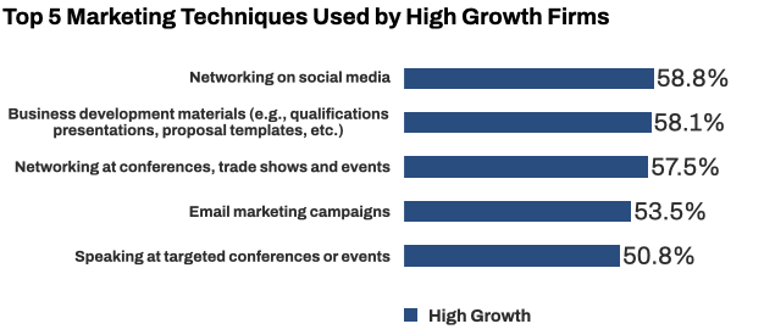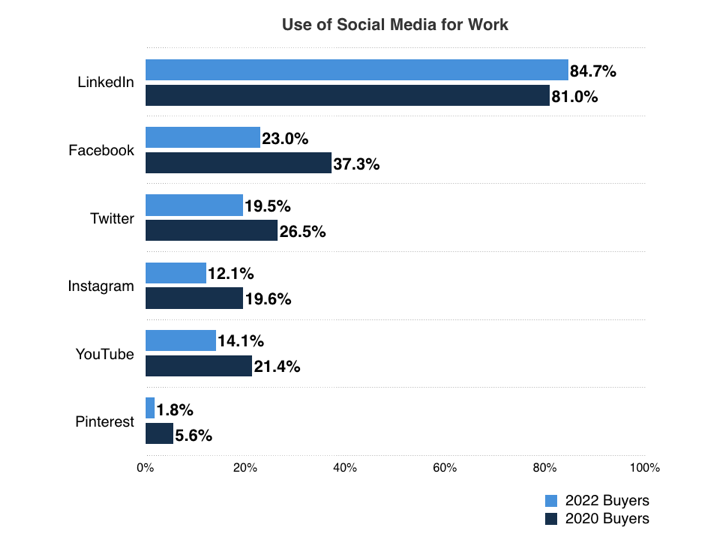Written by: Joe Pope
If it isn’t your first visit to this website, you are probably well aware of Hinge’s healthy obsession with researching the marketing habits found within High Growth professional services organizations. After all, why should they have all the fun?!
And if this is your first visit – Welcome! Feel free to stay awhile and check out the wealth of resources Hinge has created just for you.
Shameless content plug aside, the lessons learned from successful businesses can make all the difference and help to turn things around quickly for those suffering from ineffective or inefficient marketing and business development practices.
It is not a stretch to say that High Growth firms are far more likely to leverage tactics that can generate results and not to sink time or money into lower-performance techniques.
To get at these insights, I asked my phenomenal team at the Hinge Research Institute to segment and analyze data from the latest High Growth Study on the marketing techniques used by professional services firms that outperform their peers when it comes to consecutive years of 20% growth.
Here’s what we found:

When we look at the list above, two things strike us right away:
First, networking is back, baby! In fact, two of the top three techniques represent forms of networking. More on this in a moment.
Second, all of the top five techniques have been in use for years, if not decades. So what makes them so special?
Historically, when we look at data aggregated across all professional services, the corresponding numbers in a particular industry vertical can look quite a bit different. In this case, however, the findings are remarkably similar across almost all of the industries we study, with the lone exception being law firms and legal services. You can check out your specific industry breakout report from this link if you are interested.
Download the Free Executive Summary
“Allow me to reintroduce myself.”
Those lyrics were made famous by one of the great orators of our time, Jay-Z. But I find their meaning particularly relevant when reviewing the chart above. In summary—even the greatest need to evolve.
To be crystal clear, the number one technique High Growth organizations use to market themselves—out of the entire universe of possible marketing techniques—is networking on social media.
So that means if you aren’t doing a considerable amount of social media networking, you are probably missing out on big opportunities. But what does it mean to network on social media?
As we’ve noted in previous write-ups, the data also tells us that if there is only one platform you must pay attention to on social media it is LinkedIn (sorry, Elon). Almost every one of your prospects, clients, recruits and strategic partners are on it. In fact, according to our latest study on the topic, LinkedIn was the only social media platform that saw an increase in adoption rates over a two-year period.

While I don’t have the space here to go into how to use LinkedIn to build and work your network (I’ve already covered that in this post), I can share that to use it well requires participation outside of your marketing team. LinkedIn is a powerful platform where you can share expertise with a wide but relevant audience. Influential folks with decision-making power who are deeply interested in what an expert has to say.
The expert piece is key.
We find that LinkedIn’s algorithm tends to suppress content shared by a company profile when compared to posts shared by individuals. Especially if that post contains a link that takes you off-platform.
Microsoft must want you to spend money promoting your content or something like that.
Tactics Done The Right Way
While the No Growth and Average Growth professional services organizations in our study also employ many of the same techniques, they use them to different degrees and, more importantly, with different levels of proficiency.
Take a qualifications package, for example.
A dense 80-page document, single-spaced with Arial font, may have only a fraction of the impact of a concise, beautifully designed and visually appealing, 12-slide pitch deck. Always remember that People choose service providers. So you need to learn to market in a way that will impress these mere humans who are lending you a finite period of their attention span. Often, that means serving up simple, easy-to-digest messages in appealing packages. Learning what is important to say and what isn’t is a feature of a successful firm.
Email marketing, too, can mean different things to different organizations. To one company, it may mean sending a monthly newsletter to its email list. A typical newsletter is filled with company news—announcements of new hires and promotions, pictures from the latest holiday party or group volunteer outing, and maybe an award they won.
This is not effective marketing. Most clients aren’t interested and their prospects will be even quicker to unsubscribe. It does nothing to move the needle on business development.
A true email marketing approach provides something useful to the people on your list(s). It must employ the one thing they care about—your expertise—to engage them and turn them into true followers. It should also be highly automated and customized whenever possible. Segmentation is a great approach and is included with even the most basic service providers. And don’t forget to incorporate routine tests of things like subject lines and the measurement of results to determine what resonates with your target audiences.
Multiple approaches. Dramatically different outcomes.
Download the Free Executive Summary
Maximize Your Facetime
Only a little more than a percentage point behind digital networking, in-person events have finally returned to the High Growth stage at a level not seen since the 2020 COVID-19 pandemic sent them into hiding.
While the idea of using this time-honored tradition of attending events and conferences for networking purposes may appear the same, we’ve been able to uncover a few key differences that organizations are using to maximize their effectiveness.
For one thing, social media and email are increasingly being used in conjunction with in-person appearances to increase people’s visibility at large conferences and tradeshows. Small but highly targeted organic and even paid campaigns can increase the odds that your people will make valuable connections. Others take a different approach, spending less time in the big halls and taking their networking into smaller, more intimate venues where they can maximize the quality of their interactions.
We find it particularly relevant that speaking at conferences also makes the top-five list. While not technically networking, speaking elevates your credibility and visibility in a way that is difficult to replicate by any other means. It instantly positions you as an authority in your field and makes any subsequent networking you do more fruitful.
Again, the expert piece is key.
So Now What?
The findings we share in this article only begin to scratch the surface of what makes High Growth organizations stand out from their slower-growing peers. Quality over quantity and truly differentiated and relevant messaging are what make these top five marketing techniques most effective.
Related: Why Partnership Marketing Should Be Central to Your Strategy



